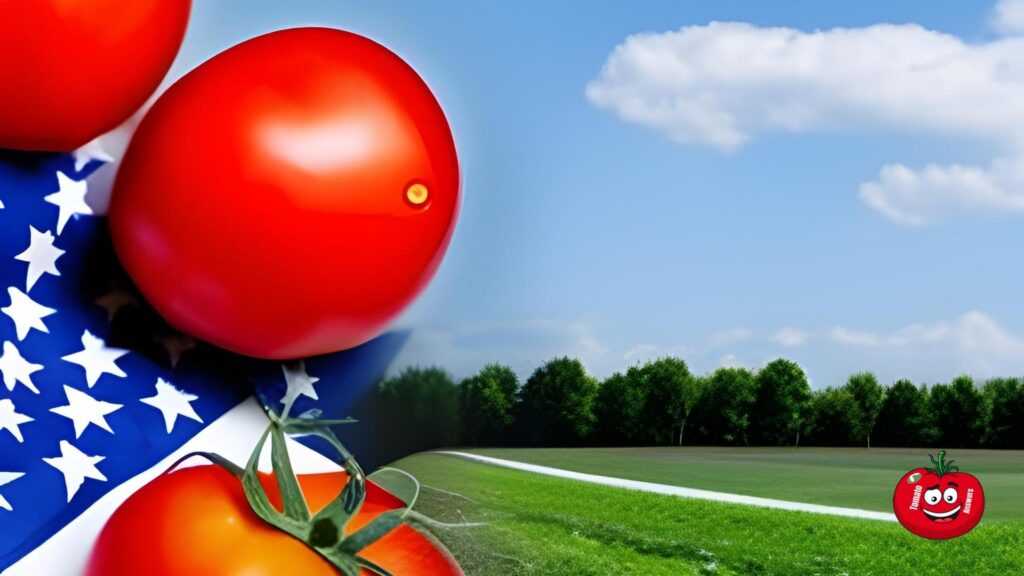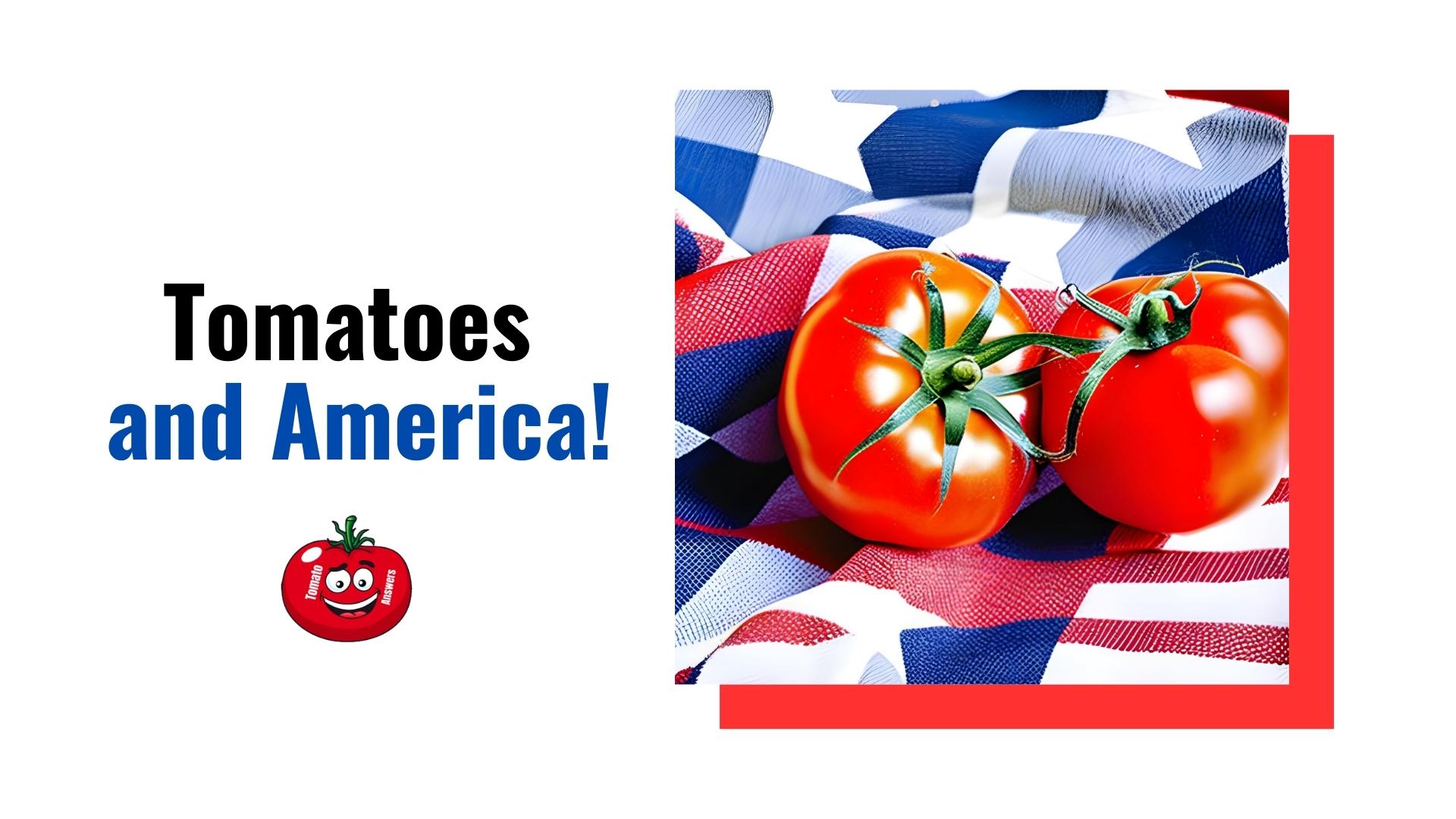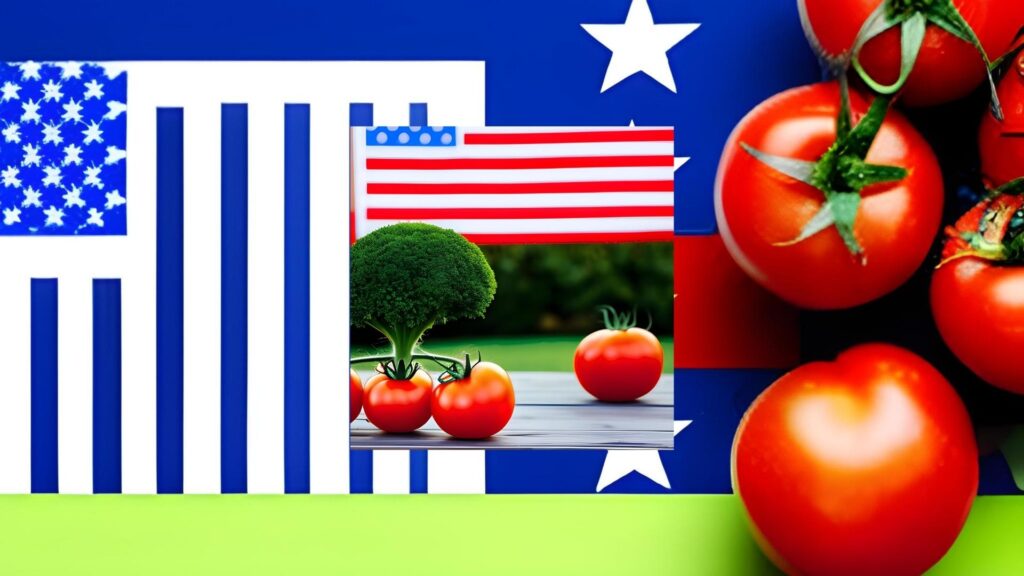The humble tomato holds a special place in the hearts and kitchens of Americans. Its vibrant colours, juicy flesh, and versatile nature have made it a staple ingredient in countless national dishes.
In this article, we will delve into tomatoes’ intriguing journey and deep-rooted connection with American cuisine.

The American Love Affair with Tomatoes
Tomatoes have captured Americans’ taste buds and imaginations from east to west, north to south. Whether it’s the classic tomato sauce on a New York-style pizza or the refreshing slices adorning a California salad, its presence is undeniable.
Its tangy-sweet flavour and ability to complement various ingredients have made it an essential component of American cooking.
An Overview of the Role of Tomatoes in American Cuisine
The tomato’s role in American cuisine extends far beyond its use as a mere ingredient. It has become a symbol of summertime, backyard barbecues, and farm-to-table freshness.
From the vine-ripened heirlooms cherished by food enthusiasts to the convenient canned tomatoes found in pantries, this versatile fruit (yes, it’s technically a fruit!) has found its way into the hearts of home cooks and professional chefs alike.
Historical Roots: Origins of the Tomato
To truly understand the significance of tomatoes in America, we must explore their historical roots and the fascinating journey they undertook before reaching the shores of the New World.
From Aztec Cultivation to Global Dispersion
The story of tomatoes begins in ancient Mesoamerica, where the Aztecs cultivated and consumed a wild relative of the modern tomato. These early varieties were small, yellow, and significantly different from the plump, red tomatoes we know today.
Through trade and exploration, tomatoes gradually made their way across the globe, reaching Europe and other parts of the world during the age of exploration.
Early Arrival and Perception of Tomatoes in America
It wasn’t until the 16th century that tomatoes arrived in North America, brought by Spanish explorers and settlers. However, their initial reception was met with skepticism and even fear.
Some early American colonists believed tomatoes were poisonous due to their resemblance to the deadly nightshade plant. Despite this, tomatoes found their place in American gardens, and gradually, their true potential began to be realized.
The story of tomatoes and America is one of rediscovery and reverence. From their humble origins in Mesoamerica to becoming a cherished ingredient in American cuisine, tomatoes have left an indelible mark on our culinary heritage.
Join us as we continue this journey, exploring the transformation of tomatoes in American kitchens, their diverse uses, and the enduring love affair between Americans and this remarkable fruit.
The Early American Tomato: Myths and Misconceptions
Tomatoes as Poisonous Ornamentals
In the early days of America, tomatoes faced a perplexing challenge – they were widely considered poisonous and grown solely for decorative purposes.
This misconception stemmed from their resemblance to the toxic nightshade family of plants. While people admired the tomato’s vibrant appearance, they were cautious about consuming it, fearing potential harm.
Breaking Through the Fear: The Role of Thomas Jefferson
One man played a pivotal role in dispelling the myths surrounding tomatoes and paving the way for their acceptance in American cuisine: Thomas Jefferson.
As an avid gardener and food enthusiast, Jefferson grew various tomato varieties in his Monticello estate. By cultivating and consuming tomatoes, he challenged the prevailing belief of their toxicity, encouraging others to do the same.
The Tomato and the American Civil War
The Emergence of Canning Technology
The 19th century witnessed significant advancements in food preservation techniques, and canning emerged as a revolutionary technology.
Canned goods, including tomatoes, provided a means of preserving and transporting food for extended periods. This development was crucial during the conflict when access to fresh produce was limited.
Tomato Rations: A Lifeline for Soldiers
During the American Civil War, canned tomatoes became a vital source of nutrition for soldiers on the battlefield. These convenient rations offered a taste of home and provided essential vitamins and minerals.
In their preserved form, Tomatoes contributed to the sustenance and well-being of troops during challenging times.
Late 19th Century: The Tomato Gains Traction
Growing Popularity in Cookbooks and Kitchens
As the 19th century progressed, tomatoes gradually found their way into American cookbooks. Recipes featuring tomatoes as ingredients started to appear, highlighting their versatility and culinary potential.
Home cooks embraced this newfound ingredient, experimenting with tomato-based sauces, soups, and stews. The tomato’s tangy flavour and rich colour added a delightful dimension to American cuisine.
Expanding Production and Spread to the American West
With the expansion of railroads and improved transportation networks, tomatoes became more accessible to people across the United States. Agricultural advancements facilitated increased production, and the tomato industry flourished.
As tomato cultivation spread to the fertile lands of the American West, the fruit became a staple in regional dishes, reflecting the country’s diverse culinary traditions.
The 20th Century Tomato: Industrialization and Standardization
The Role of the Campbell Soup Company
In the early 20th century, the Campbell Soup Company significantly shaped the tomato industry. Their development of condensed tomato soup revolutionized the way Americans consumed tomatoes.
The convenience and consistent quality of canned tomato soup made it a popular choice for busy households, solidifying the tomato’s position as a pantry staple.
The Introduction of the Hybrid Tomato
As agricultural practices advanced, hybrid tomato varieties were developed, offering improved disease resistance, higher yields, and enhanced flavour.
These hybrids became prevalent in commercial farming, ensuring a steady supply of tomatoes to meet the growing demand of American consumers. Introducing hybrid tomatoes marked a new era of tomato cultivation, emphasizing productivity and uniformity.
Tomatoes and World War II: Victory Gardens
During World War II, home gardening initiatives known as Victory Gardens encouraged citizens to grow food to support the war effort.
Tomatoes were among the most popular crops cultivated in these gardens, providing a fresh and nutritious source of sustenance. Victory Gardens alleviated food shortages and instilled a sense of self-reliance and community spirit.
As we journey through the historical development of tomatoes in America, we witness their transformation from misunderstood ornamentals to cherished ingredients and symbols of resilience.
The Post-War Tomato: The Supermarket Era
Refrigeration and the Rise of the Supermarket
The post-World War II era significantly changed how Americans acquired and consumed tomatoes. The widespread adoption of refrigeration technology allowed for better preservation and longer shelf life, making it possible to stock fresh produce in supermarkets.
This development marked the beginning of an era where tomatoes, once a seasonal delight, became available year-round in the produce sections of supermarkets across the country.
Changes in Taste and Texture: The ‘Perfect’ Tomato
With the rise of industrial agriculture, tomatoes changed to meet the demands of mass production and distribution. Varieties were bred for uniform appearance, durability, and extended shelf life.
However, in pursuing the “perfect” tomato, some argued that flavour and texture were compromised. The focus shifted from taste to convenience, and tomatoes became more uniform in appearance but often lacked the robust flavour of heirloom varieties.
The Tomato in Modern American Cuisine
Tomatoes as a Staple in Classic Dishes
Despite the changes brought about by industrialization, tomatoes remained a fundamental ingredient in classic American dishes. From the iconic BLT sandwich to the beloved tomato-based pasta and pizza sauces, tomatoes continued to be a vital component of American culinary traditions.
Their natural acidity, vibrant colour, and distinct flavour profile elevated the taste of these dishes, making them beloved staples in households and restaurants nationwide.
Innovative Uses and Culinary Experiments
In modern American cuisine, chefs and home cooks continuously explore new ways to incorporate tomatoes into their recipes. From creative tomato-based cocktails to innovative tomato-infused desserts, the versatility of this fruit knows no bounds.
Tomatoes find their way into salsas, chutneys, gazpachos, and countless other culinary creations, adding a fresh and vibrant twist to traditional and contemporary dishes.
The Organic Movement and the Heirloom Tomato
A Backlash Against Industrial Tomatoes
As awareness of industrial farming practices grew, a backlash against mass-produced tomatoes emerged. Concerns about chemical use, environmental impact, and flavour loss prompted a shift towards organic and sustainably-grown alternatives.
Consumers sought tomatoes with more authentic flavours and textures, resulting in a resurgence of interest in heirloom tomatoes.
The Rise of Farmers Markets and the Heirloom Tomato
Farmers’ markets became a gathering place for those seeking the exceptional qualities of heirloom tomatoes. These varieties passed down through generations, offered diverse colors, shapes, and flavors.
Farmers’ markets provided a direct connection between growers and consumers, allowing for a deeper appreciation of the heirloom tomato’s unique characteristics and the stories behind their cultivation.
Future of the Tomato in America
A. Breeding for Flavor: The Search for the Perfect Tomato
Recently, a renewed focus has been on breeding tomatoes for exceptional flavor. Breeders and farmers are working to develop varieties that combine the desirable traits of both heirloom and hybrid tomatoes. The aim is to create tomatoes with vibrant flavors, robust textures, and disease resistance, offering consumers the best of both worlds.
The Role of Genomic Science in Tomato Cultivation
Advancements in genomic science have opened up new possibilities for tomato cultivation. By understanding the genetic makeup of tomatoes, scientists can identify genes responsible for flavour, nutritional content, and disease resistance. This knowledge allows for targeted breeding programs, potentially developing even more remarkable tomato varieties.
Conclusion: Tomatoes, A Symbol of American Cuisine
Recapping the Journey of Tomatoes in America
The story of tomatoes in America is one of transformation, adaptation, and enduring popularity. From their early myths and misconceptions to widespread acceptance as a beloved ingredient, tomatoes have journeyed through history, reflecting the nation’s changing culinary landscape and cultural shifts.
The Ongoing Rediscovery and Reverence
Today, tomatoes capture the imagination of chefs, home cooks, and food enthusiasts. The ongoing rediscovery and reverence for tomatoes highlight their integral role in American cuisine.
Whether enjoyed in classic dishes, innovative recipes, or treasured heirloom varieties, tomatoes symbolize freshness, flavour, and the vibrant spirit of American cooking.
FAQs About Tomato & America
Why Were Tomatoes Once Considered Poisonous In America?
The misconception that tomatoes were poisonous in America stemmed from their resemblance to plants from the nightshade family, some of which are toxic.
This confusion led to the belief that tomatoes were unsafe for consumption. It wasn’t until individuals like Thomas Jefferson began cultivating and consuming tomatoes that their true nature as a nutritious and flavorful fruit started to be recognized.
How Did The Canning Industry Impact The Popularity Of Tomatoes?
The canning industry played a significant role in popularizing tomatoes. The advent of canning technology allowed for the preservation of tomatoes in a convenient and long-lasting format.
Canned tomatoes became widely available, enabling people to enjoy tomatoes throughout the year, even when fresh produce was scarce. This accessibility and availability contributed to tomatoes’ increased usage and popularity in American kitchens.
Why Were Tomatoes Once Considered Poisonous In America?
The misconception that tomatoes were poisonous in America stemmed from their resemblance to plants from the nightshade family, some of which are toxic. This confusion led to the belief that tomatoes were unsafe for consumption.
It wasn’t until individuals like Thomas Jefferson began cultivating and consuming tomatoes that their true nature as a nutritious and flavorful fruit started to be recognized.
How Did The Canning Industry In America Impact The Popularity Of Tomatoes?
The canning industry played a significant role in popularizing tomatoes. The advent of canning technology allowed for the preservation of tomatoes in a convenient and long-lasting format.
Canned tomatoes became widely available, enabling people to enjoy tomatoes throughout the year, even when fresh produce was scarce. This accessibility and availability contributed to tomatoes’ increased usage and popularity in American kitchens.
Are All Tomatoes Red In America?
No, not all tomatoes are red in America. While the red tomato varieties are the most commonly known and consumed, tomatoes come in diverse colors. Yellow, orange, green, purple, and even striped types exist.
Each color variation often exhibits its unique flavor profile, adding to tomatoes’ culinary exploration and visual appeal.
Are Tomatoes Originally From America?
Yes, tomatoes are native to western South America and Central America. The pre-Incan civilizations in these regions first domesticated them.
Who Introduced Tomatoes To America?
Tomatoes are native to the Americas, so they didn’t need to be introduced. However, Spanish explorers returning from the New World brought them to Europe in the 16th century, and they eventually made their way back to North America via European settlers.
When Were Tomatoes Brought To America?
While tomatoes are originally from the Americas, European settlers introduced the variety we are most familiar with back to North America, likely in the early 18th century.
How Are Tomatoes Used In America?
In America, tomatoes are used in many dishes, including salads, sandwiches, sauces, soups, and salsas. They are also canned annually and processed into products like tomato paste and ketchup.
What Country Are Tomatoes From?
Tomatoes are originally from the Andean region in South America, encompassing modern-day Peru, Ecuador, and Bolivia.
Why Are American Tomatoes So Big?
American tomatoes are often larger due to selective breeding for size, growing conditions, and techniques that favor larger fruit.
Was Tomatoes Introduced To Europe Or America?
Tomatoes were introduced to Europe by Spanish explorers in the 16th century, after which they eventually made their way back to North America with European settlers.
Which Country Has The Tastiest Tomatoes?
This can be subjective and based on personal taste. However, many argue that Italian and Spanish tomatoes, particularly the sun-ripened varieties, are among the tastiest.
Why Buying USA Tomatoes Matters?
Buying USA tomatoes supports local farmers and economies. Furthermore, domestically grown tomatoes can be fresher, as they spend less time in transit and have a smaller carbon footprint due to reduced transportation distances.
When Did Tomatoes Come To Europe?
Tomatoes were introduced to Europe by Spanish explorers in the 16th century, where they were initially grown as ornamental plants before being recognized for their culinary value.
Are You New To Tomato Answers?
If you are new to Tomato Answers, here are a few resources to help you:
- Curious about the origins of tomatoes? Discover if Are Tomatoes Native to America?
- Living in Oklahoma and planning your tomato garden? Learn When to Plant Tomatoes in Oklahoma.
- Not sure about the best time to plant in Indiana? Discover When to Plant Tomatoes in Indiana.
- Planning your tomato garden in Iowa? Find out When to Plant Tomatoes in Iowa.
- Looking to grow tomatoes in the beautiful state of Colorado? Learn When to Plant Tomatoes in Colorado.
- Planting tomatoes in the sunny state of Florida? Here’s When to Plant Tomatoes in Florida.
- Planting tomatoes in the vast lands of Alaska? Learn When to Plant Tomatoes in Alaska.
References
- Berry Ottaway, P. (2001) The roots of a healthy diet. Chemistry and Industry 22 January, pp. 42-45
- Giovannucci, E. et al. (1995) Intake of carotenoids and retinal in relation to risk of prostate cancer. Journal of the National Cancer Institute 87 1767-1776
- Nestlé, M. (1995) Mediterranean diets. American Journal of Clinical Nutrition 61 (6) Supplement 1313S-1427S

